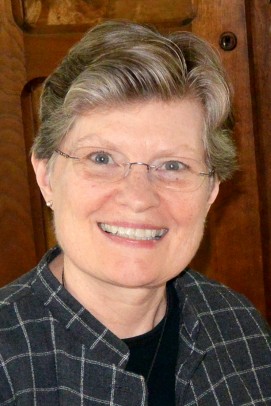Smithsonian museum’s stamp collector extraordinaire

To develop new stamp exhibits, “the trick was for everybody to start thinking big,” says Cheryl Ganz, chief curator of philately at the Smithsonian National Postal Museum.
By Jamie Malanowski — UIC Alumni magazine
Following the credo “every stamp tells a story,” Cheryl Ganz transformed the vision of philately at the Smithsonian National Postal Museum and institutions around the world.
Ganz, who earned a Ph.D. in history from the College of Liberal Arts and Sciences in 2005, recently retired as chief curator of philately at the Smithsonian museum.
Ganz received the 2015 UIC Alumni Achievement Award Sept. 18, presented by UIC Chancellor Michael Amiridis.
“Her impact on the hobby has been huge,” says Gordon Morrison, former head of the U.S. Postal Service’s stamp program. “She has demonstrated many times how stamps, well presented, can reach very diverse audiences and make history come alive.”
“The customary way museums exhibited their collections was almost like a stamp album or catalog,” Ganz explains.
“Here are stamps 1, 2 and 3 from countries A, B and C. Bor-ring! I wanted to bring more excitement to our exhibits, to use stamps as a way of understanding the larger events that produced them. There was a great team at the museum, great curators. The trick was for everybody to start thinking big.”
During her decade in charge of philatelic content and exhibitions, the museum canned the rows of small sticky squares depicting mostly-forgotten monarchs. Instead, stamps were the centerpieces in exhibits such as “Fire and Ice,” tales of the giant, ill-fated transports the Hindenburg and the Titanic, and “Delivering Hope,” the story of how President Franklin Roosevelt, a lifelong stamp collector, used stamps to fight the Great Depression.
Stamps make history come alive
“We brought in more film and interaction for young people, and set up a photo booth where you could turn a photograph of yourself into a vintage line engraving on a stamp,” Ganz says. “We also built exhibits around rare pieces of mail owned by the museum, including a letter from John Hancock, dated July 4, 1776. We tried to make the whole experience fun, as well as educational.”
Her interest in stamps began early. “I was a natural collector,” she says. “My grandfather gave me an old photograph of a zeppelin,” one of the giant, gas-filled airships that ruled transoceanic air travel during the early part of the 20th century. After that, she began accumulating everything having to do with airships.
“One day at a flea market, I acquired an envelope that had been on the Graf Zeppelin, and that was it.” Her passion for zeppelins became a passion for stamps and mail.
Evolving into a social and cultural historian, Ganz became a kind of Object Whisperer, extracting stories from scrapbooks, brochures and other items ostensibly mute. A native Chicagoan, she had a special appreciation for subjects related to the city: the 1933 flight of the Graf Zeppelin to the Chicago World’s Fair and Mexican pottery made at Hull-House.
After the death of her husband, Ganz decided to pursue a Ph.D. at UIC.
“The faculty was incredible,” she says. “They taught me skills I wouldn’t have thought I needed. Knowing how to ask big questions; setting a goal beyond the [original] goal; looking at lots of evidence, and letting it lead you to your conclusion.”
After completing her doctorate in 2005, Ganz interviewed for the chief curator position at the Smithsonian and landed the job. After a decade of inspired leadership, she retired with the seldom-bestowed title curator of emerita, the only National Postal Museum employee to receive that honor.
